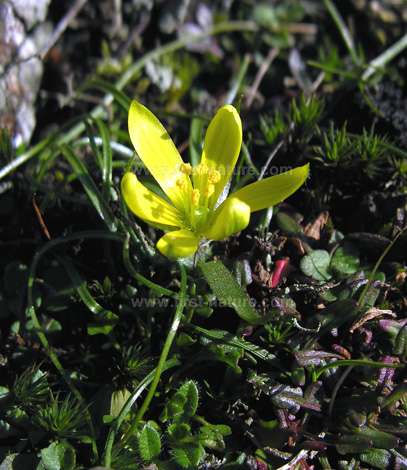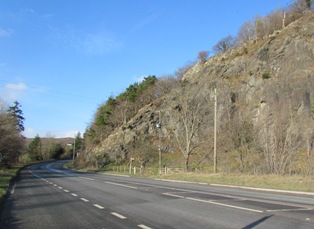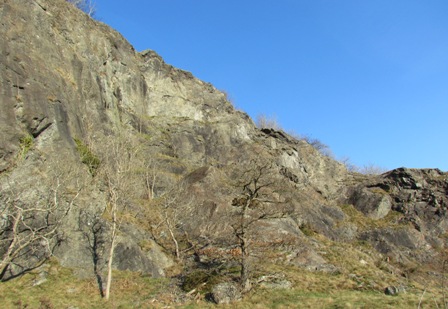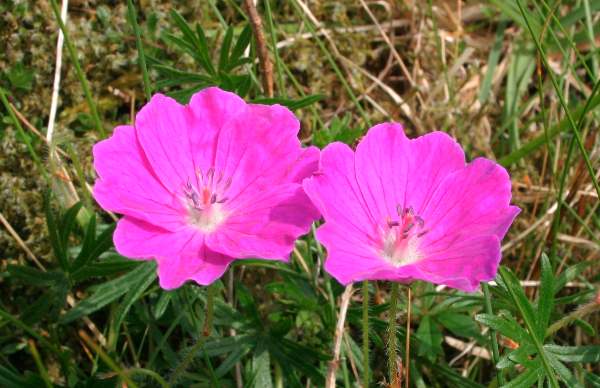Stanner Rocks National Nature Reserve (in Powys), Near Kington, Herefordshire.
Designations: Stanner Rocks SSSI
Below: The Radnor Lily (Gagea bohemica) - Stanner Rocks NNR is the only place in Britain where this lovely plant is known to grow.

This national nature reserve is a paradise for those interested in rare and unusal plants; it has many species that are rare in Britain and more frequently associated with the Mediterranean region.
The reserve largely comprises a steep outcrop of igneous rock with thin soils lying on its surface and in shallow hollows. The southerly aspect of this outcrop allows the soils to warm up very quickly in spring, ensuring the survival of plants that are used to more balmy climates than are usually encountered in Wales.
The shallow, fast drying soil also limits rank and more agressive plants from encroaching on the site and either competing with or even eradicating the rare species.
The only area of the reserve that is generally open to the public is the part accessed from an entrance that leads into the former quarry part of the reserve. Please the level parts only of the quarry floor in the reserve, carefully avoiding thin soils and bare or moss-covered rock which may support various uncommon and obscure plants. Do not enter other parts of the reserve without being accompanied by Natural Resources Wales (NRW) staff. If you would like to see the other parts of the reserve contact the NRW staff via their telephone helpline on 0845 1306229, or by email: enquiries@naturalresourceswales.gov.uk Supervision is required not only because of the extremely sensitve nature of the plants and their habitats at Stanner Rocks but also because the reserve is for the most part precipitious, slippery and dangerous to visit without proper guidance.
Please tread carefully if you visit this site. It is best to keep your feet on the tougher grasses to avoid damage to the very delicate plant life of Stanner Rocks.
Stanner Rocks National Nature Reserve is managed by Natural Resources Wales (NRW).
Directions
Grid Ref: SO263584
From Kington in Herefordshire, England follow the main A44 road in the direction of Rhayader.
The entrance to Stanner Rocks NNR is off the right hand side of the A44, just across the Wales Border, immediately opposite the left-hand turn onto the B4594 road to Builth Wells.
Access to the reserve is via a roadside gate and then down a short hardcore-surfaced track.
Informal parking is possible beside the B4594 very close to the reserve. There is no Parking close to the reserve on or beside the A44.
Below: The entrance to Stanner Rocks NNR is off the main A44 road

Access
Access to this NNR is restricted because of the sensitivity of its wildlife habitats and species and because the terrain is dangerous. If unaccompanied the only part of the reserve available to the public is the level area inside the old quarry part of Stanner Rocks NNR close to the entrance.
If unaccompanied the best route through the reserve is approached from opposite the A44 Gore Quarry entrance nearest Walton (Grid reference: SO 260592). Climb over the stile beside the locked metal gate and walk along the track, through a gate and up the forestry track about one mile to a turning circle. Continue along the track another 100m to double metal gates, and then proceed without branching off to the right, until you reach the track's highest point (good view point to the East), or walk up to the summit of the ridge, but do not enter the reserve below which is situated through a fence. Visitors are welcome to walk within the top enclosure where ponies or sheep may be present. Please return by your arrival route and public paths or tracks, or return to the turning circle previously passed, and then follow the path that lies just within the woodland edge and down hill below the reserve and on to the quarrry floor. Please avoid walking through the reserve.
The top enclosure has slippery slopes, steep drops, rough ground and thorny plants.
Facilities
There are no facilities at the reserve. The nearest pubs, shops, cafés and public toilets are in Kington which is about 5km from the reserve.
Description of Site
Stanner Rocks NNR is the only location in Britain where the Early Star-of-Bethlehem (Gagea bohemica) - also known as the Radnor Lily -can be found. This lily is better known from mainland Europe, and theidentification of the plants at Stanner Rocks was only confirmed as recently as 1978. One plant had been accidentally collected in 1965 and a further specimen was collected in 1974. Both of these plants, which had shrivelled, gone-over whitish petals, were thought to be Snowdon Lilies (Lloydia serotina), although this location was well outside the known range of the Snowdon Lily.
Below: Rocky by name and rocky by nature - Stanner Rocks NNR

These two plants differed from Lloydia serotina because they were hairy, a feature not known for the Snowdon Lily. However, another visit to Stanner Rocks in 1975 by Ray Woods (a specialist in lower plants) revealed a single fresh-flowered specimen with bright-yellow petals; this discovery led to the plants' final confirmation as Gagea bohemica in 1978.
The thin soils in and around Stanner Rocks NNR support other wildflowers that are either rare or unusual for this part of Britain. Among these are Spiked Speedwell (Veronica spicata), Sticky Catchfly (Lychnis viscaria), Rock (also known as English) Stonecrop (Sedum anglicum), Common Rockrose (Helianthemum nummularium) and Bloody Crane's-bill (Geranium sangineum). The special stonecrop found in the reserve is Sedum forsterianum.
At Stanner Rocks NNR there are also some nationally rare mosses and liverworts.
Below: Bloody Crane's-bill, surely one of our most beautiful wildflowers

The wonderful wildflowers of the nature reserve attract many insects, and Stanner Rocks is a particularly good place to see lots of butterflies on warm, sunny days in summer. More than 27 species have been recorded there, among them the Wall Brown (Lasiommata megera) and the Silver-washed Fritillary (Argynnis paphia).
Another delight of this lovely little nature reserve is that all of our native British woodpeckers live there - the Great Spotted Woodpecker (Dendrocopos major), Lesser Spotted Woodpecker (Dendrocopos minor) and the Green Woodpecker (Picus viridis). The least shy of the three is undoubtedly the Green Woodpecker, which forages for insects in grassy places and often seems unconcerned by our presence until we overstep the mark by trying to get too close to them. Usually their distinctive yelping cry gives away their presence long before they are seen.